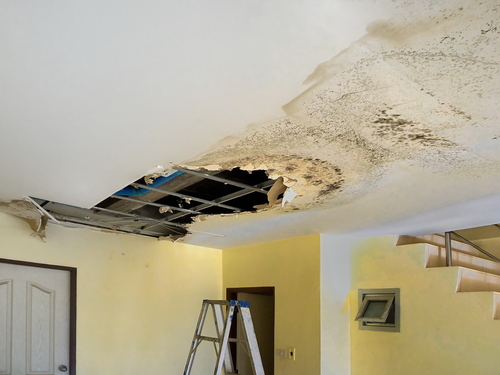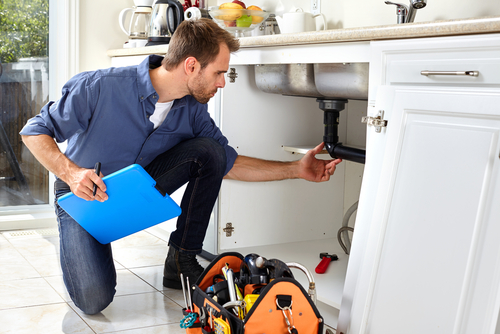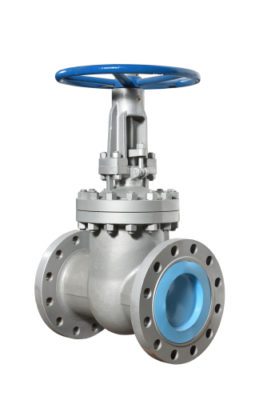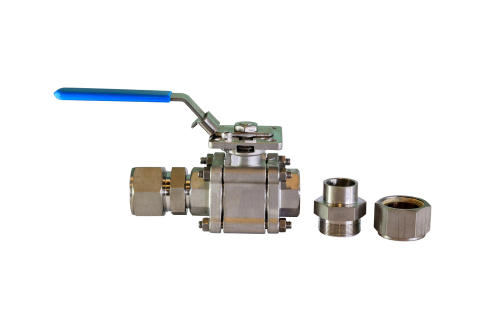
Water issues in a rental property are more than just an inconvenience. In fact, water can lead to extensive damage, mold growth, health hazards, and expensive repairs if not immediately addressed. That said, when a pipe burst and water is pouring into your home, it is easy to become overwhelmed. So, knowing how to find and operate the property’s water shut-off valve are essential to mitigating damage. Join us below as we walk you through the steps needed to address emergencies and prevent water damage in your rental home.
Steps to Prevent Water Damage When a Leak Appears
When water appears, from whatever source, quick action can be the difference between minor and major repairs. Keep the list of steps below handy, so when disaster strikes, you will be ready!
- Find the Shut Off Valve – Ideally, locate and mark the water valve during your move-in walkthrough with the landlord. Typically, it can be found in a utility area, basement, or garage area.
- Turn Off the Water – Once you find the valve, turn off the water. However, before doing so, make sure you understand how the type of valve the property has worked. We will discuss more of this below!
- Minimize Damage – When a leak or burst pipe happens, do what you can to minimize damage to the surrounding area. So, catch water in a container, move furniture or personal items out of harm’s way, and mop up the excess to prevent water damage.
- Notify Your Property Manager – After the initial steps are complete and the damage is contained, contact your property manager to report the issue. They will then take necessary action to repair the problem and further prevent excessive damage.
- Repair and Replace – Water damage is a maintenance emergency, given how fast mold can take hold. The owner or property manager must contact a qualified vendor to repair any damage and fix the core issue to prevent water damage. Once necessary repairs are complete, the vendor will turn the water on and ensure no further leaks persist.
How to Locate the Water Shut Off Valve
Shutting off the water to prevent water damage, perform maintenance, or stave off an emergency is an essential skill. Therefore, being able to locate the valve quickly is vital. So, if you were never shown where the water shut-off valve is, follow these tips to try and locate it.
- From outside, find the water meter for the house. From there, make a straight line to the home’s perimeter, and where the water line meets the house is generally close to where the shut-off valve is.
- In some cases, the water shut-off valve will be behind an access panel.
- In newer homes, look for a plumbing collection point where large pipes come in and branch off throughout the house. Typically, these pipes have a valve to shut off water to the entire home.
- Know where to look based on where you are on the property. For example, if you are in the basement, look at eye level or above. However, if searching on the first floor, focus your eyes lower.
Types of Water Shut Off Valves and How to Close Them
The type of water shut-off valve your rental property has makes a difference in how you operate it in an emergency. So, let’s review the most common types of valves and how to shut them off to prevent water damage.
 Gate Valve
Gate Valve
A gate valve has a round handle similar to a standard hose faucet. This is sometimes referred to as a sluice valve and operates by lifting or lowering a barrier in the path of fluid flowing through the pipe.
- How to Close a Gate Valve – Turn the handle several times in a clockwise direction until the gate fully engages in closing off the water supply.
 Ball Valve
Ball Valve
Unlike a gate valve with its round handle, ball valves have a straight pivoting handle. Turning the handle engages a pivoting hollow ball to control flow. When open, water flows freely through the hole. However, when the handle turns a quarter turn to the off position, a ball pivots to stop the flow forcibly.
- How to Close a Ball Valve – The open position for a ball valve is when the handle runs parallel to the pipe. Therefore, to close it, turn the handle a quarter turn or 90 degrees perpendicular to the pipe.
Exterior Water Valves
Outdoor spigots and pipes are very susceptible to freezing if not taken care of properly. If you live in an area that experiences winter weather, seasonally turning off water to these outside pipes is essential. Also, remember to disconnect, drain, and properly store any outdoor hoses.
- How to Close Exterior Water Valves – Locate the exterior water valve inside the property and turn it off according to the type of valve it is. Then, go back outside and turn on the exterior spigots to drain any remaining water in the pipe.
Other Types of Water Shut Offs
A leak or burst pipe can happen anywhere throughout the home. In some cases, it may not be necessary to shut off water to the entire property, but instead just an affected area. However, generally, these types of upstream shut-off valves are found in newer properties. That said, when an emergency occurs, shutting off water as close to the problem area is best. Let’s look at a few examples of this below –
- Bathtub or Shower – If the bath has exposed plumbing pipes, the shut-off valves may be visible. In such a case, turn the valves clockwise until off to quickly stop the flow to the damaged area.
- Sinks – Under the sink, you should see one or more pipes. Look for the valves and turn them clockwise to the off position. However, use care as these are sometimes made of plastic that can easily become damaged themselves.
- Toilet – Behind the toilet, near the floor, should be a flexible metal tube with a valve. To shut off the water supply, turn it carefully clockwise until it stops – but be careful not to force it.
- Washing Machine – In many modern homes, pipes close to the washing machine will have a convenient shut-off valve. Depending on the type of valve, turn clockwise until closed or for ball valves, turn perpendicular to the pipe.
Keep in mind, especially with older homes, that valves can be fragile. Especially if they do not get much use or are made of a material such as plastic. When an emergency requires you to turn off the water, ensure that you do not become overzealous and damage the valve by overturning.
Tips for Preventing Mold Growth
Wet building materials, walls, or flooring can become a breeding ground for mold. Therefore, no matter how the water got in, immediate action is needed. After all, mold needs very little to flourish and can completely take hold in as little as 48 hours. So, follow these few steps to help prevent costly mold damage below –

- Remove Affected Materials and Dry the Area – Carefully clean and dry any affected areas within 48 hours. This is essential to preventing mold growth. In addition to mopping and wiping up visible water, drying fans will also help.
- Inspect the Area Often – Once you are confident the area is sufficiently dry, continue to monitor for signs of mold growth over a couple of days. Generally, mold growth will result in discoloration and a musty or damp odor.
- Replace Any Damaged Materials – Sometimes, it is better to replace than clean certain types of materials. For example, if something cannot be thoroughly dried, consider replacing things such as drywall and insulation. Although this is added expense for landlords, it is cheaper than mold remediation.
How Landlords Can Help Prevent Water Damage
One of the best ways landlords can help prevent water damage is through open communication with their tenants. However, that is not the only way. So, check out our tips below –
Educate Your Tenants
Tenants can better address an emergency if they already know where things are and what to do. So, when inspecting the unit, show the tenant where to find and how to use important mechanisms like the water shut off. Additionally, marking the water shut-off valve in some way will make it easier to find. Also, make sure tenants can spot the warning signs of a leak developing or mold growth taking hold.
Address Maintenance Quickly
Water damage is very costly, and so is the risk of allowing mold to begin in untreated repairs. That said, having a solid process in place for how maintenance needs are handled is critical to your success and the protection of your property. Ensure the tenant knows who to contact and keep a shortlist of trusted vendors you can count on in your hour of need.

Hire a Property Manager
Hiring a qualified property manager can instantaneously relieve a lot of stress for property owners. Bay Property Management Group is the area’s fastest-growing rental management firm serving Central Maryland, Washington DC, Northern Virginia, and Southern Pennsylvania. Our team of experts helps protect your investment property through thorough tenant screening, resident education, inspections, along with preventative and emergency maintenance coordination. So give us a call today to learn more about why full-service property management may be right for you.

 Gate Valve
Gate Valve Ball Valve
Ball Valve